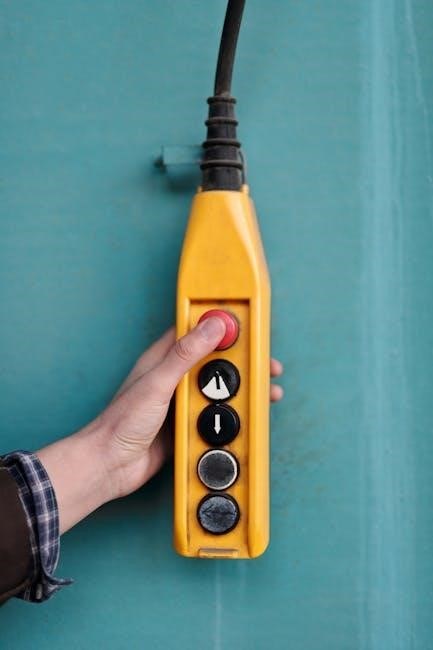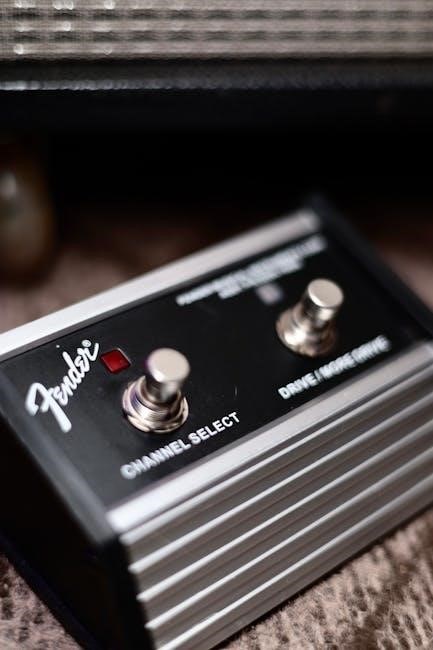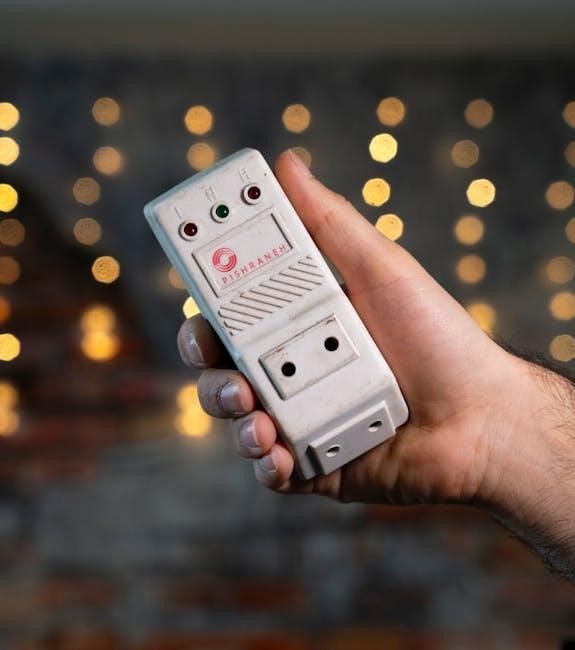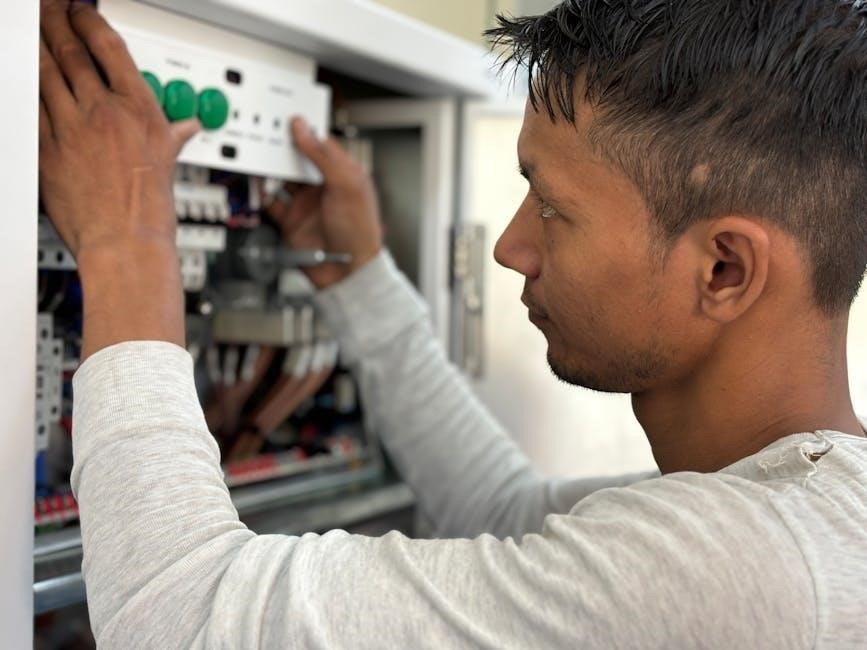A 50 Amp manual transfer switch enables safe transitions between utility and generator power, handling up to 50A and 10 circuits. It ensures temporary power during outages, providing reliability and convenience for residential and light commercial use.
1.1 What is a Manual Transfer Switch?
A manual transfer switch is a critical component in backup power systems, enabling users to safely switch between utility power and a generator during outages. Designed for reliability, it ensures seamless transitions without risking electrical damage or hazards. The 50 Amp model can handle up to 50 amps of power and manage multiple circuits, typically up to 10 or 12, providing flexibility for powering essential appliances. By installing a manual transfer switch, homeowners and businesses can avoid the hassle of extension cords and ensure continuous power supply to critical systems. It is a straightforward, cost-effective solution for temporary power needs, offering peace of mind during emergencies.
1.2 Purpose and Functionality
The primary purpose of a 50 Amp manual transfer switch is to provide a safe and reliable way to switch between utility power and a backup generator during power outages. Its functionality ensures continuous power supply to essential circuits, preventing disruptions to critical systems like lighting, HVAC, and appliances. Designed for manual operation, it allows users to safely transfer power sources, eliminating the risk of backfeeding and electrical damage. The switch is engineered to handle high power demands, making it suitable for both residential and commercial applications. By organizing power distribution efficiently, it ensures maximum safety and convenience during emergency situations.

Key Features of a 50 Amp Manual Transfer Switch
A 50 Amp manual transfer switch offers high power capacity, compatibility with generators, and robust safety features. It ensures reliable power distribution and overload protection, making it ideal for residential and commercial use.
2.1 Power Capacity and Circuit Handling
A 50 Amp manual transfer switch is designed to handle high electrical loads, making it suitable for residential and light commercial applications. With a power capacity of 50 Amps, it can manage up to 12,000 watts of power safely, ensuring reliable operation during power outages. The switch supports both 120/240-volt systems, allowing it to handle multiple circuits efficiently. Its robust construction ensures consistent power delivery, while overload protection prevents damage to connected devices. This feature-rich design makes it ideal for generators, providing a seamless transition between grid and backup power sources.
2.2 Compatibility with Generators
A 50 Amp manual transfer switch is specifically designed to work seamlessly with generators, ensuring a reliable backup power solution during outages. It is compatible with both portable and standby generators, supporting up to 12,000 watts of power. The switch allows for a smooth transition between grid and generator power, minimizing disruptions. Its design ensures safe operation, protecting both the generator and connected circuits from overloads. With a focus on versatility, it accommodates various generator models and brands, making it a flexible choice for different power needs. This compatibility ensures that users can maintain essential power supply efficiently and safely.
2.3 Safety and Temporary Power Solutions
A 50 Amp manual transfer switch prioritizes safety by preventing backfeeding, which protects utility lines and equipment from damage. It serves as a temporary power solution, allowing users to connect a generator during outages safely. The switch is designed to handle up to 12,000 watts, making it ideal for emergency power needs. Its compact design and durable construction ensure reliable performance in various conditions. With clear indicators for source selection, it minimizes the risk of errors. Additionally, it supports both 120/240V systems, ensuring compatibility with most generators. This makes it a versatile and secure option for temporary power requirements, enhancing safety and convenience for users.

Types of Transfer Switches
Transfer switches are categorized into manual and automatic, single-phase and three-phase, and indoor or outdoor-rated options, each designed for specific applications and environments.
3.1 Single-Phase vs. Three-Phase Systems
A 50 amp manual transfer switch can be designed for either single-phase or three-phase electrical systems. Single-phase systems, common in residential settings, use two wires (live and neutral) and are suitable for lighter power demands. Three-phase systems, typically used in commercial or industrial environments, utilize three live wires and a neutral, offering higher power capacity and efficiency for heavy-duty applications. The choice between them depends on the load requirements and the type of generator or power source being used. Always ensure the transfer switch matches the system type to avoid compatibility issues and safety hazards.
3.2 Indoor vs. Outdoor Rated Switches
50 amp manual transfer switches are available in indoor and outdoor ratings, each designed for specific environments. Indoor-rated switches are suitable for dry, protected areas like homes or commercial spaces, offering basic protection against dust and light splashing. Outdoor-rated switches, however, are built to withstand harsh weather conditions, including rain, snow, and humidity, making them ideal for outdoor installations. They often feature weatherproof enclosures with higher NEMA ratings (e.g., NEMA 3R) to ensure safe and reliable operation in exposed environments. Choosing the correct rating is essential for safety, durability, and compliance with local electrical codes.

Installation Considerations
Proper installation ensures safety and functionality. Hire a licensed electrician, follow local electrical codes, and ensure all connections are secure. Always disconnect power before starting work.
4.1 Pre-Installation Requirements
Before installing a 50 amp manual transfer switch, ensure your electrical panel and generator are compatible. Verify the switch’s rating matches your system’s power requirements. Check local electrical codes for compliance. Gather necessary tools like wire strippers, screwdrivers, and voltage testers. Shut off the main power supply and test for zero voltage using a multimeter. Ensure the installation location is accessible and protected from environmental elements. Review the manufacturer’s instructions thoroughly. Plan the wiring layout to avoid overcrowding and ensure proper connections. Wear appropriate PPE, including insulated gloves and safety glasses. Double-check all components for damage before starting the installation process.
4.2 Step-by-Step Installation Guide
Mount the 50 amp manual transfer switch in a location accessible to the main electrical panel and generator. Connect the switch to the panel, ensuring secure wiring. Attach the generator wires to the designated terminals on the switch. Use appropriately sized wires to prevent overheating. Install the switch between the electrical panel and generator, following the manufacturer’s wiring diagram. Configure the system to prioritize essential circuits. Test the transfer switch by simulating a power outage and switching to generator power. Ensure all connections are tight and meet local electrical codes. Finally, label the switch for clarity and perform a safety inspection with a multimeter to confirm proper operation.
4.3 Safety Tips and Best Practices
Always turn off the main power supply before installing or servicing the 50 amp manual transfer switch. Use insulated tools to prevent electrical shock. Ensure the generator and transfer switch are properly grounded to avoid hazards. Never overload the system beyond its rated capacity. Regularly inspect wires and connections for signs of wear or damage. Keep the switch in a well-ventilated area to prevent overheating. Test the system annually to ensure proper functionality. Label all circuits clearly for easy identification. Follow local electrical codes and manufacturer guidelines. Store backup power systems in a dry, secure location. Train household members on safe usage and emergency procedures to ensure preparedness during outages.

Choosing the Right 50 Amp Transfer Switch
Choosing the right 50 amp transfer switch involves assessing power needs, ensuring compatibility with generators, and considering future capacity to avoid upgrades. Consult a licensed electrician for tailored advice.
5.1 Assessing Power Needs
Assessing power needs is critical to selecting the right 50 amp transfer switch. Start by determining the total power required for your home or business. List all essential appliances and systems, such as lighting, HVAC, refrigeration, and medical equipment, and calculate their combined power consumption. Ensure the switch can handle the maximum load without overheating or tripping. Consider the voltage requirements (typically 120/240V) and the number of circuits needed. Measure the total wattage of essential circuits and verify compatibility with the switch’s 50 amp capacity. This step ensures reliable performance and avoids overload risks. Consulting a licensed electrician is recommended for accurate assessment.
5.2 Comparing Brands and Models
When comparing brands and models of 50 amp manual transfer switches, focus on key factors like power capacity, compatibility, and safety features. Look for switches rated for 50 amps at 120/240V to ensure they meet your power needs. Consider the build quality, durability, and materials used, as these impact longevity. Check for certifications like UL or ETL to ensure compliance with safety standards. Compare prices and warranty offerings, as these vary by brand; Read customer reviews to assess reliability and performance. Some popular brands offer advanced features like remote operation or smart technology. Evaluate the ease of installation and customer support provided. This helps in making an informed decision tailored to your specific requirements and budget.
5.3 Future-Proofing Your Purchase
Future-proofing your 50 amp manual transfer switch purchase involves selecting a model that adapts to evolving power needs and technological advancements. Opt for a switch with scalable design, allowing upgrades or expansions as required. Consider models with higher power capacity or modular components to accommodate potential increases in energy demand. Additionally, look for switches compatible with emerging technologies, such as smart home systems or renewable energy sources. Ensure the product is backed by a reputable brand with reliable customer support and a comprehensive warranty. Investing in a versatile and durable transfer switch ensures long-term functionality, saving costs on future upgrades and providing peace of mind for years to come.

Safety and Compliance
Ensure your 50 amp manual transfer switch meets NEC standards for safe operation. Proper installation and regular inspections are essential to prevent hazards and ensure compliance with electrical codes.
6.1 Electrical Codes and Standards
50 amp manual transfer switches must adhere to strict electrical codes and standards to ensure safe and reliable operation. Compliance with the National Electric Code (NEC) is mandatory, particularly for wiring, load calculations, and generator connections. These switches are designed to meet NEMA (National Electrical Manufacturers Association) ratings and UL (Underwriters Laboratories) standards for safety and performance. Proper installation requires adherence to local and national regulations to prevent hazards like overloading or electrical fires. Always verify that the switch is certified by recognized testing organizations and follows guidelines for temporary power solutions. Non-compliance can lead to legal issues and safety risks, making adherence crucial for both residential and commercial applications.
6.2 Safe Usage Guidelines
Safe usage of a 50 amp manual transfer switch requires careful attention to prevent electrical hazards. Always ensure the switch is installed by a licensed electrician to meet local codes. Before switching power sources, turn off all connected loads to avoid surges. Use the switch only during emergencies or maintenance, never as a permanent solution. Keep the switch accessible and unobstructed for easy operation. Regularly inspect the switch for wear or damage, and test it under no load to ensure proper function. Never operate the switch in wet conditions or with wet hands. Follow the manufacturer’s instructions for maximum safety and reliability.
6.3 Maintenance Requirements
Regular maintenance is essential to ensure the reliability and longevity of a 50 amp manual transfer switch. Start with visual inspections to check for signs of wear, corrosion, or dust buildup. Clean the contacts and surfaces with a soft brush or approved electrical cleaner to maintain proper conductivity. Lubricate moving parts, such as hinges and levers, to ensure smooth operation. Test the switch periodically under no load to confirm it functions correctly. Replace any worn or damaged components immediately. Keep a record of maintenance activities and perform an annual inspection by a licensed electrician to ensure compliance with safety standards and optimal performance.

Applications and Benefits
A 50 amp manual transfer switch is ideal for residential and commercial backup power systems, ensuring reliable electricity during outages. It offers flexibility, safety, and efficiency, making it a versatile solution for generator connections, while providing peace of mind and minimizing downtime in critical situations.
7.1 Residential Use Cases
A 50 amp manual transfer switch is widely used in residential settings to connect backup generators during power outages. It ensures seamless power delivery to essential appliances like refrigerators, HVAC systems, and lighting. Homeowners can safely switch between utility and generator power, minimizing downtime. The switch is ideal for homes with standby generators, providing a reliable solution for emergency power needs. Its compact design and ease of installation make it a practical choice for residential use. Additionally, it supports energy efficiency by allowing homeowners to manage their power sources effectively, ensuring continuous comfort and safety during outages.
7.2 Commercial and Industrial Applications
In commercial and industrial settings, a 50 amp manual transfer switch is essential for managing power distribution during outages. It ensures uninterrupted operation of critical systems, such as lighting, machinery, and data centers. Factories, warehouses, and retail spaces rely on these switches to maintain productivity and safety. The switch is also used in industrial facilities to power backup generators, preventing equipment damage and downtime. Its durability and scalability make it suitable for high-demand environments. Additionally, it supports compliance with industrial safety standards, ensuring reliable power management in demanding conditions. This makes it a vital component for businesses requiring consistent and efficient power solutions.
7.3 Advantages Over Traditional Methods
A 50 amp manual transfer switch offers significant advantages over traditional methods of power management. It provides a reliable and efficient way to switch between primary and backup power sources, ensuring minimal downtime during outages. Unlike older systems, it incorporates advanced safety features like overload protection and precise current monitoring. The switch is also designed for durability, with high-quality materials that withstand harsh conditions. Additionally, it simplifies the process of connecting generators, making it user-friendly for both residential and commercial users. Its compact design saves space and reduces installation complexity compared to bulky traditional setups. Overall, it enhances safety, efficiency, and convenience in power distribution systems.

Top Recommended Products
When selecting a 50 amp manual transfer switch, several top-rated models stand out for their performance and reliability. The Reliance Controls Pro/Tran 50-Amp Transfer Switch is widely praised for its durability and ease of installation. Another excellent option is the Generac 50-Amp Manual Transfer Switch, known for its compatibility with Generac generators and user-friendly design. The Eaton 50-Amp Manual Transfer Switch is also a top choice, offering robust construction and superior safety features. These models are UL-listed, ensuring compliance with safety standards. When choosing, consider your specific power needs, generator compatibility, and installation requirements to select the best product for your system.

Troubleshooting Common Issues
Common issues include the switch not functioning, blown fuses, or the generator not starting. Always check the fuse or circuit breaker first. Ensure the generator is running properly before switching. If issues persist, consult a licensed electrician for professional assistance.
- Check for loose connections or damaged wires.
- Verify the generator’s fuel and oil levels.
- Ensure the switch is rated for your generator’s power output.
9.1 Identifying Common Problems
Identifying common problems with a 50 amp manual transfer switch involves checking for issues like the switch not functioning, blown fuses, or the generator not starting. Users may also experience power fluctuations or the switch failing to transfer power. Loose connections, damaged wires, or incorrect installation are frequent culprits. Additionally, overload conditions or improper sizing of the switch for the generator can cause malfunctions. Always verify the switch’s compatibility with the generator’s power output. If the switch feels warm or emits a burning smell, it may indicate an internal fault. Regular inspections can help detect issues early, preventing potential hazards.
9.2 DIY Solutions and Repairs
For DIY repairs on a 50 amp manual transfer switch, start by ensuring the power is off. Check for loose connections and tighten them if necessary. If the fuse is blown, replace it with one of the correct rating. Inspect the switch for wear or damage; if damaged, replace it. Verify the generator’s output matches the switch’s capacity. Use a multimeter to test for continuity and ensure proper wiring. For stuck switches, apply a silicone-based lubricant. Always follow the manufacturer’s instructions and safety guidelines. If issues persist, consult a licensed electrician to avoid further complications or safety risks.

Warranty and Customer Support
Most 50 amp manual transfer switches come with a 1-5 year warranty. Manufacturers offer customer support through phone, email, or online portals for troubleshooting or replacements.
10.1 Understanding Warranty Terms
Warranty terms for 50 amp manual transfer switches vary by manufacturer but typically range from 1 to 5 years. These warranties usually cover parts and labor for manufacturing defects or faulty materials. Understanding the warranty ensures protection against unexpected failures. Most warranties exclude coverage for normal wear and tear or misuse. It’s essential to review the terms to know what’s covered and what’s not. Filing a claim often requires proof of purchase and adherence to specific procedures. Manufacturers may also offer extended warranty options for added protection. Always check the warranty details before purchasing to ensure it aligns with your needs and expectations.
10.2 Accessing Customer Service
Accessing customer service for a 50 amp manual transfer switch is typically straightforward. Most manufacturers offer support through phone, email, or live chat on their official websites. Many provide 24/7 availability for urgent inquiries. Online resources like FAQs, user manuals, and troubleshooting guides are also available to address common issues. For warranty-related questions or technical support, customers can contact the manufacturer directly. Some companies offer dedicated helpline numbers or support portals. Ensuring quick and reliable customer service is crucial for resolving issues promptly and minimizing downtime. Manufacturers often prioritize customer satisfaction, making their support teams accessible and responsive to user needs.
A 50 amp manual transfer switch is an essential component for ensuring reliable power delivery during outages. It offers a safe and efficient way to switch between a primary power source and a generator. By understanding its features, installation requirements, and safety guidelines, users can make informed decisions. Choosing the right model depends on power needs, compatibility, and future-proofing. Proper installation and maintenance are crucial for optimal performance and safety. With the right transfer switch, homeowners and businesses can enjoy uninterrupted power supply during emergencies. Always consider top-rated products and manufacturers to ensure durability and reliability. This guide provides a comprehensive overview to help users make the best choice for their needs.
